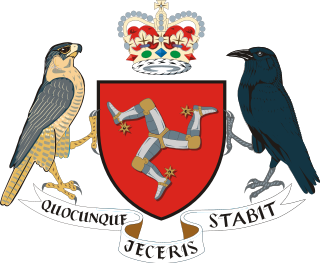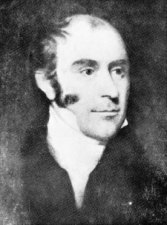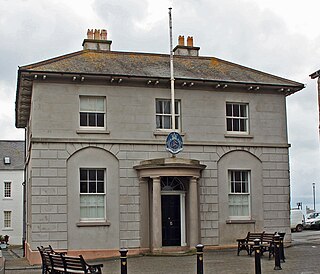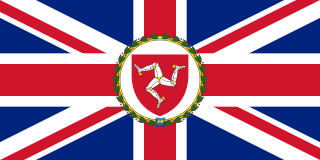
Nelson's Column is a monument in Trafalgar Square in the City of Westminster, Central London, built to commemorate Vice-Admiral Horatio Nelson's decisive victory at the Battle of Trafalgar over the combined French and Spanish navies, during which he was killed by a French sniper. The monument was constructed between 1840 and 1843 to a design by William Railton at a cost of £47,000. It is a column of the Corinthian order built from Dartmoor granite. The statue of Nelson was carved from Craigleith sandstone by sculptor Edward Hodges Baily. The four bronze lions around its base, designed by Sir Edwin Landseer, were added in 1867.

The Monument to the Great Fire of London, more commonly known simply as the Monument, is a fluted Doric column in London, England, situated near the northern end of London Bridge. Commemorating the Great Fire of London, it stands at the junction of Monument Street and Fish Street Hill, 202 feet (61.6 m) in height and 202 feet west of the spot in Pudding Lane where the Great Fire started on 2 September 1666. Constructed between 1671 and 1677, it was built on the site of St Margaret, New Fish Street, the first church to be destroyed by the Great Fire. It is Grade I-listed and is a scheduled monument. Another monument, the Golden Boy of Pye Corner, marks the point near Smithfield where the fire was stopped.

Tynwald Day is the National Day of the Isle of Man, usually observed on 5 July.

Castletown is a town in the Isle of Man, geographically within the historical parish of Malew but administered separately. Lying at the south of the island, it was the Manx capital until 1869. The centre of town is dominated by Castle Rushen, a well-preserved medieval castle, originally built for a Viking king.
King William's College is a co-educational private school for pupils aged 3 to 18, located near Castletown on the Isle of Man. It is a member of the International Baccalaureate and Headmasters' and Headmistresses' Conference organisations. The College operates at two sites in or near Castletown: a main senior school campus on the shore of Castletown Bay, and a prep school in the Westhill part of Castletown, two miles from the main campus. The College was originally for boys only, but became co-educational in the 1980s. It has roughly five hundred pupils.

Illiam Dhone or Illiam Dhône, also known as William Christian, was a Manx politician and depending on viewpoint, patriot, rebel or traitor. He was a son of Ewan Christian, a deemster. In Manx, Illiam Dhone literally translates to Brown William—an epithet he received due to his dark hair—and in English he was called Brown-haired William. Dhone was a significant figure in the Isle of Man during the English Civil War and the Manx Rebellion of 1651. He was executed for high treason in 1663. In the centuries after his death he has become a "martyr and folk-hero, a symbol of the Island's cherished freedoms and traditional rights".

The Tower of Refuge from Shipwreck, referred to as the Tower of Refuge, is a stone-built castellated structure which was erected on St Mary's Isle in Douglas Bay, Isle of Man, in order to afford shelter to mariners wrecked on the rock. The tower was constructed through the endeavours of Sir William Hillary, who had been instrumental in several rescues of sailors stranded on the rock, and which culminated in the heroic rescue of the crew of the Saint George Steam Packet Company steamer RMS St George, when it foundered on the rock in the early hours of 20 November 1830. Sir William personally contributed a high proportion of the costs and secured a substantial number of public contributions for funding the structure.

A Deemster is a judge in the Isle of Man. The High Court of Justice of the Isle of Man is presided over by a deemster or, in the case of the appeal division of that court, a deemster and the Judge of Appeal. The deemsters also promulgate the Laws on Tynwald Day by reading out brief summaries of them in English and Manx.

Hop-tu-Naa is a Celtic festival celebrated in the Isle of Man on 31 October. It is the celebration of the traditional Gaelic festival of Samhain, the start of winter. It is thought to be the oldest unbroken tradition in the Isle of Man.

Sir William Hillary, 1st Baronet was a British militia officer, author and philanthropist, best known as the founder, in 1824, of the Royal National Lifeboat Institution.

John McHutchin, was a Manx lawyer who successively became High Bailiff of Douglas, Second Deemster and Clerk of the Rolls in the Isle of Man.

The Old House of Keys is the former meeting place of the House of Keys, the lower house of Tynwald, the Isle of Man's parliament. It is located across the street from Castle Rushen in Castletown, the former capital of the Isle of Man, in the south of the island. The building was used as the House of Keys from 1821 until 1874, when the parliament was moved to Douglas.

Government House is the official residence of the Lieutenant Governor of the Isle of Man. It is situated on Governor's Road in Onchan, Isle of Man. Government House is also used to provide accommodation for official guests to the Isle of Man, and is used extensively for official functions, such as receptions and dinners. The property has been the official residence of the Lieutenant Governor since 1863 and has been owned by Tynwald since 1903.

The lieutenant governor of the Isle of Man is the Lord of Mann's official personal representative in the Isle of Man. He has the power to grant royal assent and is styled "His Excellency".

Cornelius Smelt was an administrator who served as Lieutenant Governor of the Isle of Man from 1805 until his death in 1832, the longest governorship in the history of the Island. An officer in the British Army, he served first with the 14th Regiment of Foot and then the 35th Regiment of Foot, acting as Deputy Governor of Southsea Castle in the late 18th century. His governorship of the Isle of Man is remembered as one in which he displayed great moral courage in difficult circumstances. His wisdom and fortitude in the long period when the House of Keys and the Duke of Atholl fought their historic political battles were also evident. Upon his death, a memorial was erected in Castletown in the Isle of Man.

The Deemster is a novel by Hall Caine published in 1887, considered to be the first 'Manx novel'. It was Caine's third novel, the second to be set in the Isle of Man and it was his first great success. The plot revolves around the reckless actions of Dan Mylrea and the exile and atonement that follow.

Sir James Gell, was a Manx lawyer, who was the First Deemster and Clerk of the Rolls in the Isle of Man. He was also the first Manxman to become Attorney General of the Isle of Man.

James Stowell Gell QC was a Manx advocate who became High Bailiff of both Castletown and Douglas, Isle of Man.
John Kelly was a Manx advocate who became High Bailiff of Castletown and a Member of the House of Keys.

The Smelt Portrait is an 1826 painting in oils of the Lieutenant Governor of the Isle of Man, Cornelius Smelt, by Thomas Barber (1771–1843). It was commissioned whilst Governor Smelt was at the height of his popularity.



















